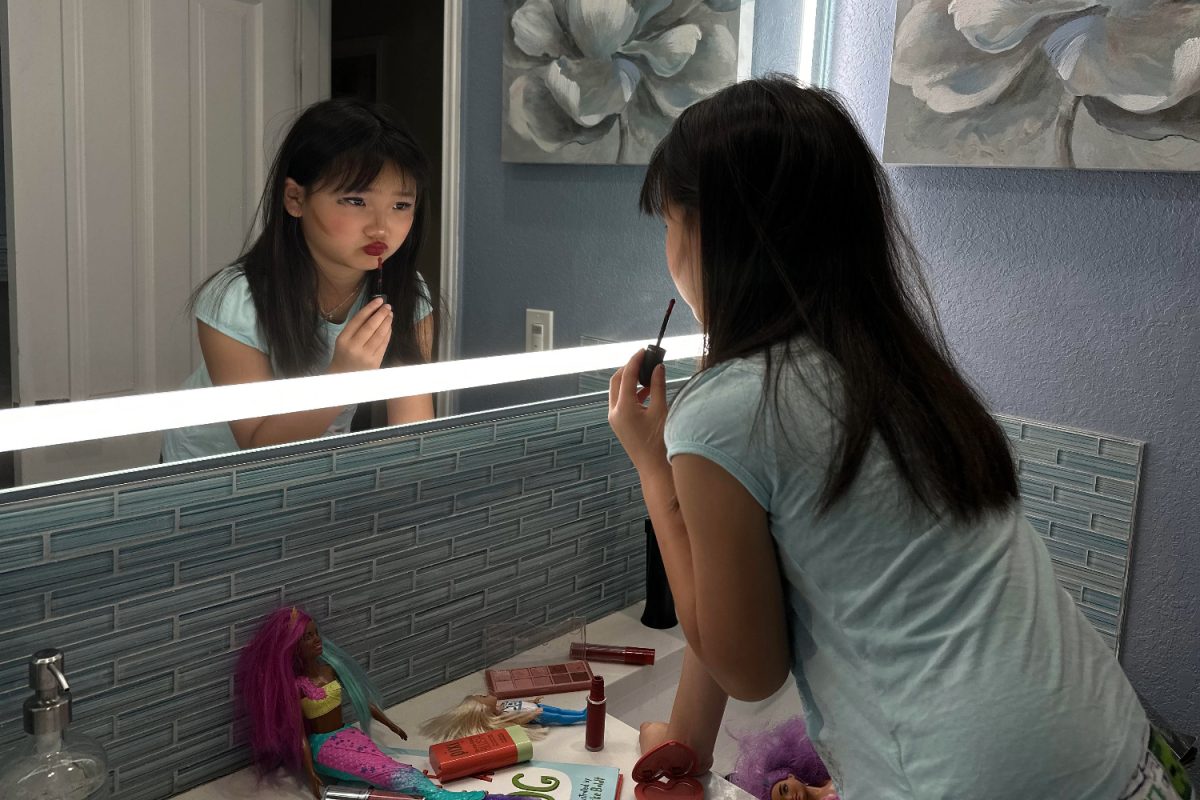A bright red lip, thick heavy eyelashes, and sharp winged eyeliner.
This sounds like the description of a celebrity on the cover of a tabloid magazine. However, this has become an increasing reality for a first-grade classroom, according to a substitute teacher. With higher levels of social media usage, teenagers and children, specifically young girls, find themselves competing against an impossible standard far too early.
According to a survey conducted by Pew Research, 97% of teenagers in the United States use the internet daily, due partially to receiving electronic devices at increasingly younger ages and the addictive design formatted by social media platforms.
While technology is a blessing in many ways, helping form more significant connections and improving education, it has also proven to be incredibly detrimental to the mental health of many. Children– especially teenagers– naturally strive to fit in and engage in comparisons. With the increased opportunities offered by the internet, the comparisons expand further.
The massive surge in social media is partially to blame.
“Social media increases opportunities to not only compare teenagers to peers at their school,” said Earl Turner, who has a master of science degree, a doctorate in clinical psychology, and a bachelor’s degree in psychology. “But now teens may compare themselves to people they don’t even know personally.”
With the introduction of modern-day technology and advancements, today’s changes vastly differ from a few years ago.
“Currently, this generation of adolescents is at risk of developing a poor self-image,” said Luna Maribel, a licensed family therapist. “Social media accounts are where people share the good in their lives, but what we see is not always the full picture. It causes a distorted perception of reality, which viewers want to emulate.”
The negativity brought forth by the internet also exposes young children to easily accessible issues. In a document made publicly available by the Office of Justice Programs’ National Criminal Justice Reference Service, Understanding Online Hate Speech as a Motivator and Predictor of Hate Crime, “online hate speech can create an environment in which offline hate crime can occur.”
Design by Skylin
The internet contains numerous sides. With some, not as positive as others.
While this is a drastic outcome, most teenagers and young children often find themselves impacted by the media in many aspects, including the positive and the negative.
“The use of the internet and social media apps has increased exposure to a lot of information that children didn’t have access to before,” Turner said. “This also means that teens have more outlets to communicate their thoughts about issues and to engage in more visible activism.”
Adolescence is one of the most vulnerable periods. According to a journal run at Northern Michigan University, it’s a relatively new concept in science and a crucial development stage in one’s life.
“Teens often experience peer pressure and are hardwired to feel accepted by their peers,” Turner said.
However, these effects aren’t limited to online. Victoria Alexander, an elementary school substitute teacher, found the influence of social media and changes produced by the pandemic significantly altered students’ academic learning.
“After the pandemic, children, more often than not, have a difficult time with their attention span when it comes to lessons if they are not learning around a computer,” Alexander said.
The vast majority of Americans (90%) have claimed that the internet has been essential to them personally during the pandemic, according to the Pew Research Center.
In a report from the nonprofit Common Sense Media, James Steyer, the founder of the program, describes the pandemic as a “unique moment in time, where the use of technology has become more of a lifeline than a threat.”
Another effect Alexander witnessed in increasingly younger classrooms was the usage of new trends from social media, such as pricey products featuring brands such as Laniege and Drunk Elephant and skincare and makeup products that gained vast popularity on TikTok.
“I have seen children as young as seven wear makeup,” Alexander said. “But no signs of insecurities, more of fun and self-expression.”
According to the National Library of Medicine, the fear of missing out (FOMO) is a relatively new term associated with problematic social media usage, experienced as a range of negative emotions and feelings related to the need to belong.
“I believe everybody had the desire to be older when they were younger,” said Mahika Reddy, a junior at Carlmont High School.
Social network platforms have almost tripled their users in the last decade. According to Backlinko, a professional marketing site, the average teenager owns up to a total of 9 social media accounts.
“As a kid, I used to pretend to hold coffees in my hand when, in reality, they were just hot chocolates,” Reddy said. “But now, especially because of TikTok, it changes the perspectives of wanting to be older to wanting to become more attractive.”
In the vast field of social media platforms, TikTok has taken the younger generation by storm. Launched in 2016 and developed by Chinese company ByteDance, it utilizes short videos and an addictive algorithm to captivate users and has quickly become a birthplace for trends.
“Some teens engage in certain behaviors due to pressure. If teens see someone else doing something, they’re more likely to engage in that behavior,” Turner said.
Nowadays, social media influencers hold significant influence over their young audience, given that it is an inherent aspect of their profession. Yet, several influencers may be directing their content towards the wrong viewers.
“Hypersexualization is a common theme amongst what social media influencers push,” Reddy said. “They’re often paid to promote products, claiming to make girls appear or feel more attractive. Intentionally or not, it convinces girls that they need this product to feel confident.”
A study conducted by Case24 found that 71% of people who took the survey used FaceTune, a photo and video editing software, before posting a picture of themselves on Instagram.
“I see young girls focusing on their appearance earlier and earlier to the point where it’s the youngest of middle schoolers trying to look hot,” Reddy said. “Honestly, it makes me sad. I never worried about the way I looked until around the middle of high school. That goes for the majority of my grade as well.”
Yet, the responses to the drastic changes observed in children and teenagers influenced by media consumption have been minimal compared to its importance.
“It’s already too out of hand; it sounds bleak, but the exponential influence of the media seems irreversible,” Reddy said.
The nonprofit Common Sense Media identifies that the “suicide rate for girls aged 10 to 14 has tripled since 1999.”
“There’s a correlation between adolescent girls’ social media use and their mental health,” said Jennifer Newsom, the first lady of California. “If that’s because girls turn to social media for self-actualization and peer interaction, we need to address social media use from a public health perspective.”
Nonetheless, there are strategies and measures that can be applied to minimize the influence experienced by ourselves and those much younger.
“I never downloaded TikTok for a long time because I knew I would get addicted to their scrolling format. Even now, I don’t have TikTok on my phone,” Reddy said.
Knowing one’s limits and habits can allow one to decide one’s social media usage. However, with the decreasing age at which children are being exposed to the internet, these limits and habits are assumed to be still unknown. Therefore, the younger generation can’t be expected to create these restrictions for themselves.
But they aren’t alone.
“It’s important for them to be kind to themselves and recognize their positive strengths. Finding a supportive group of people around them that truly care and want to see their best,” Maribel said.

































